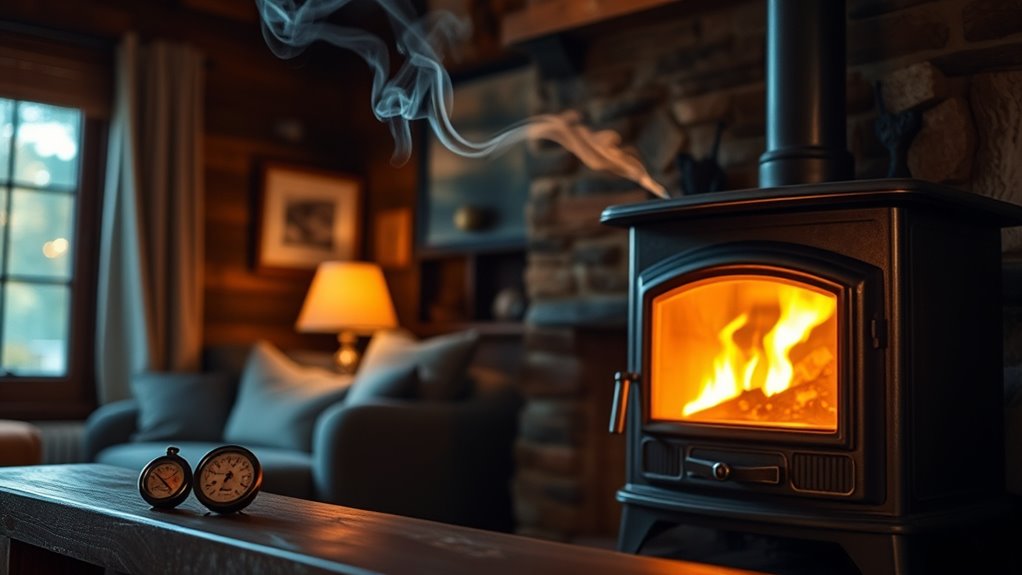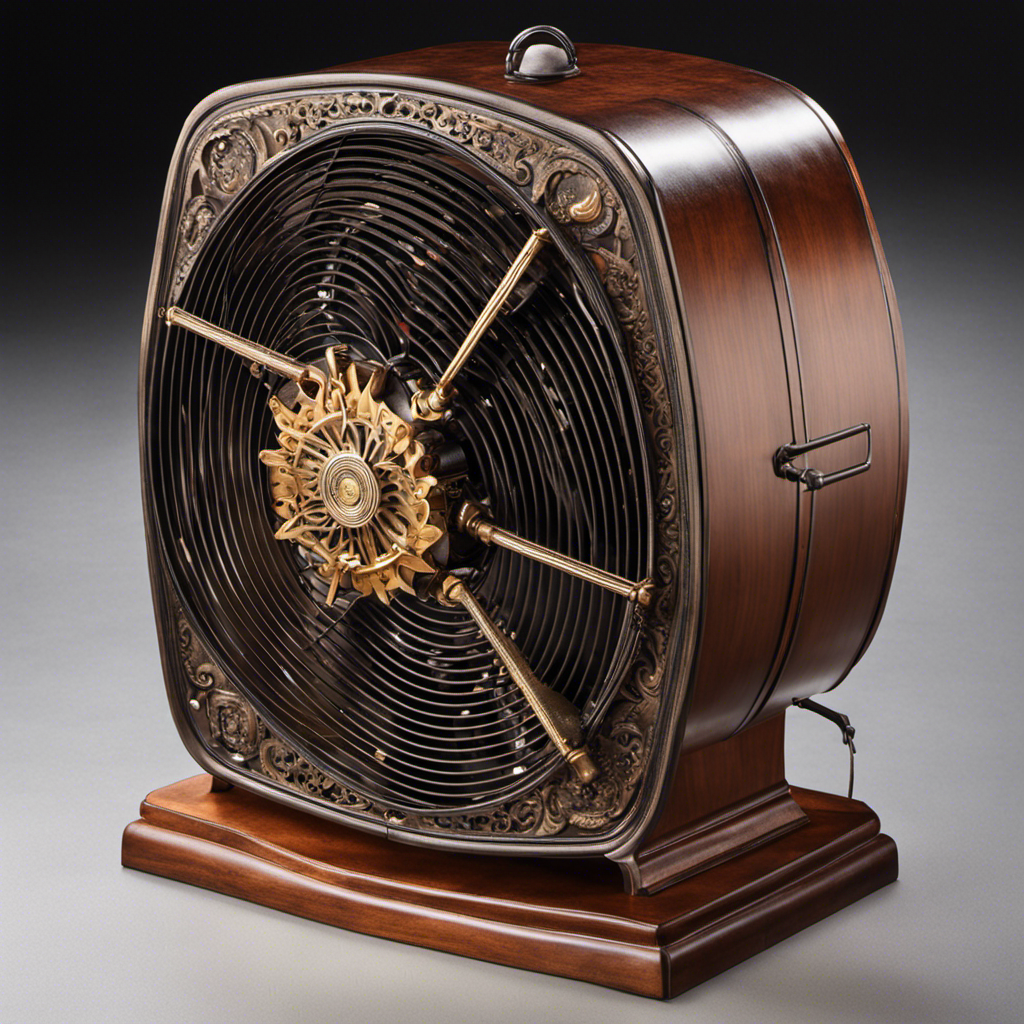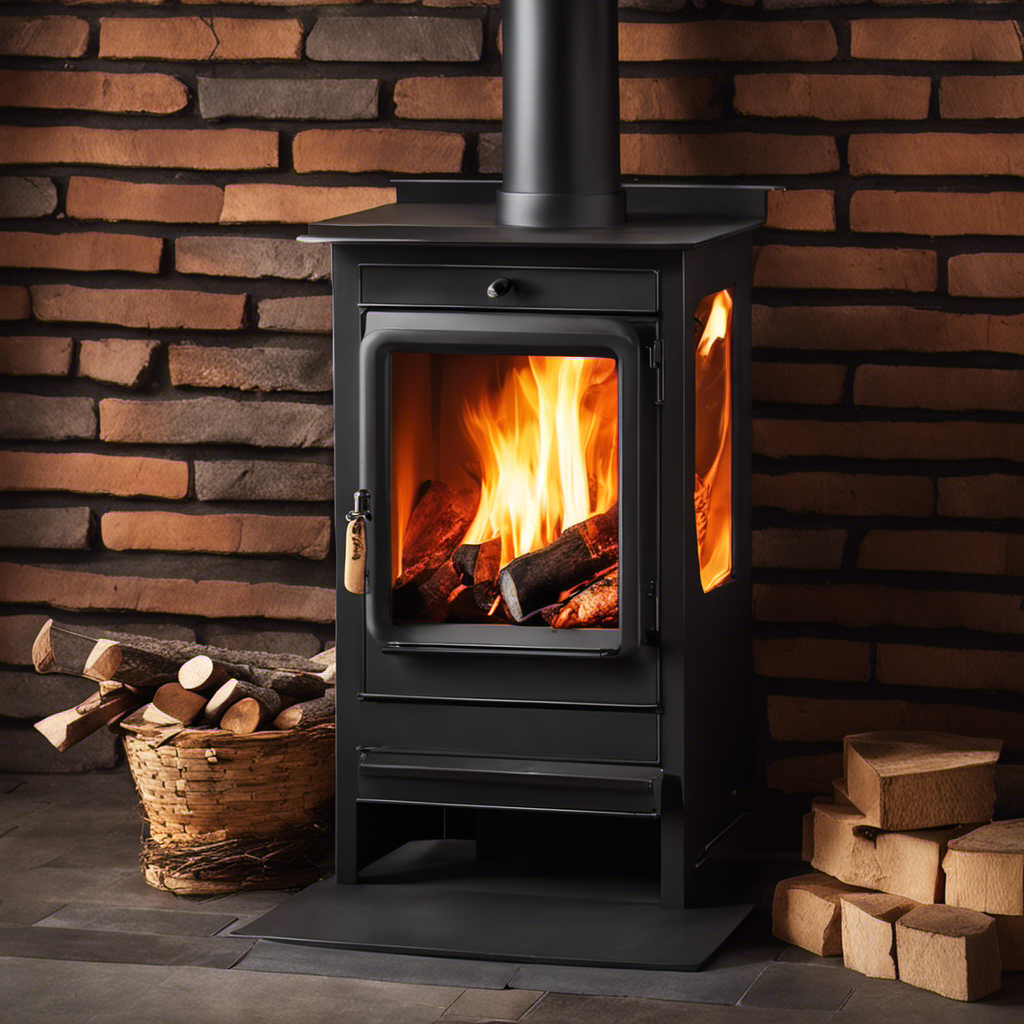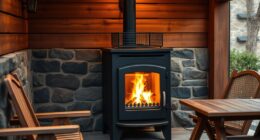Wood stoves can release pollutants like fine particulate matter, carbon monoxide, and nitrogen oxides, which harm indoor air quality and your health. Even EPA-certified models may leak pollutants during refueling or incomplete burns. Using seasoned wood, maintaining your stove, and ensuring proper ventilation help reduce emissions. Air purifiers with HEPA and activated carbon filters also improve air safety. To protect yourself and learn more, explore effective strategies to minimize pollution and stay informed.
Key Takeaways
- Wood stoves can emit pollutants like PM2.5 and carbon monoxide, impacting indoor air quality and health.
- Proper maintenance, ventilation, and burning seasoned dry wood reduce emissions and improve indoor air safety.
- Air purifiers with HEPA and activated carbon filters help lower residual smoke, gases, and particulate matter indoors.
- Vulnerable groups, including children and those with respiratory issues, face higher health risks from wood smoke exposure.
- Transitioning to EPA-certified or cleaner heating options, along with community efforts, can significantly decrease indoor pollution.
How Do Wood Stoves Affect Indoor Air Quality?
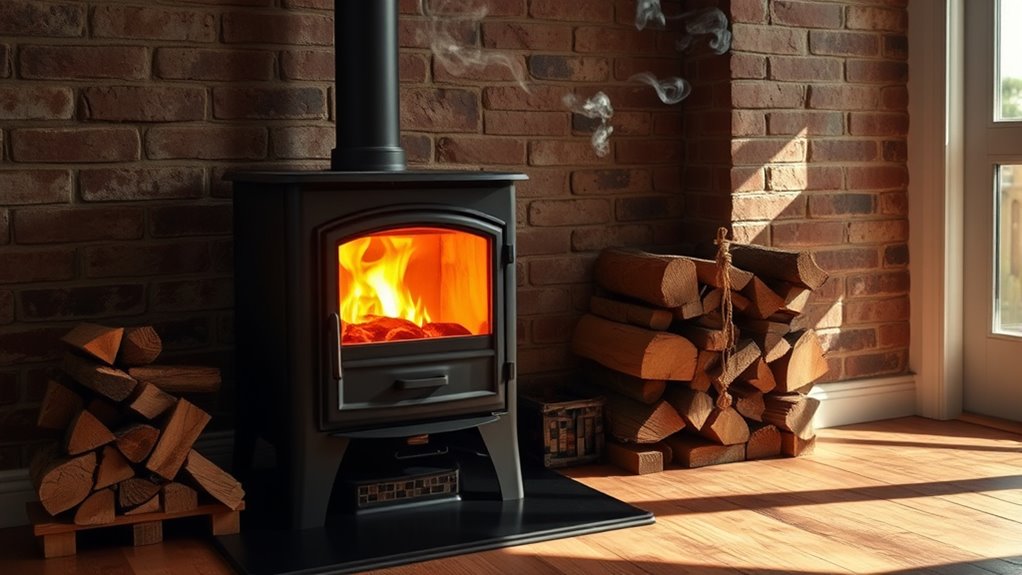
Wood stoves impact indoor air quality by releasing pollutants like fine particulate matter, nitrogen oxides, and carbon monoxide into your home. During combustion, these stoves emit pollutants that can substantially degrade indoor air quality. The fine particles, or PM2.5, are small enough to penetrate deep into your lungs and bloodstream, posing serious health risks. Even EPA-certified stoves can contribute to indoor pollution as emissions escape through cracks or vents. When you refuel or experience incomplete combustion, pollutant levels can spike two to four times higher, increasing health hazards. Proper ventilation, regular stove maintenance, and burning seasoned dry wood help reduce emissions. Additionally, understanding local business hours for inspections and services can ensure your stove remains in optimal condition. Being aware of air quality impacts caused by wood stoves can help you take steps to minimize health risks associated with their use. Recognizing pollutant sources in your home environment is essential for effective mitigation. To further protect indoor air quality, it’s important to monitor real-time indoor air pollution levels and consider installing air purification systems if necessary. Regularly upgrading ventilation systems can also help improve overall air exchange and reduce pollutant build-up. However, understanding how these pollutants affect your indoor environment is essential to minimizing health risks associated with wood stove use.
Types of Wood Stoves and Their Emissions
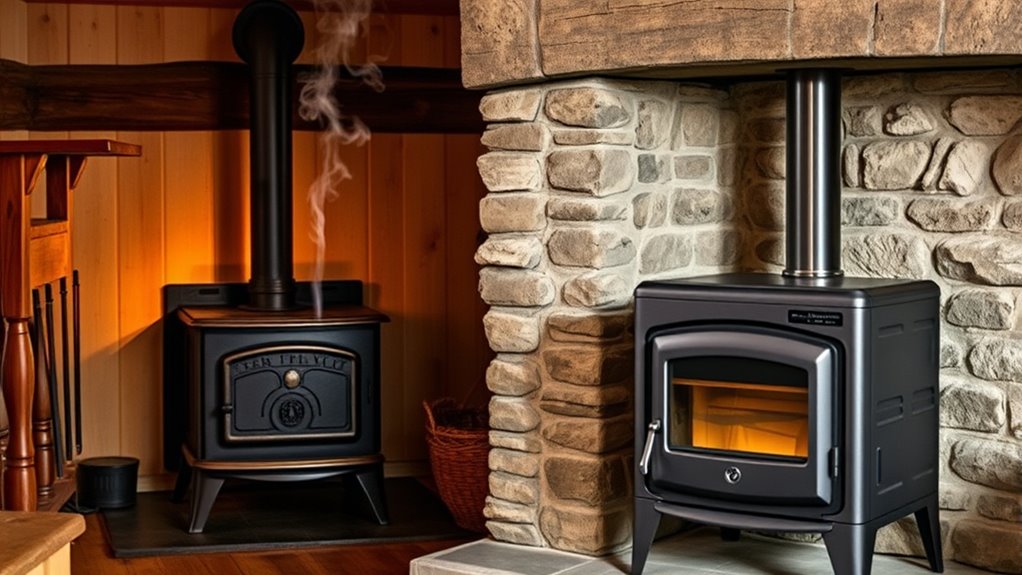
Not all wood stoves burn fuel equally or emit the same pollutants. While fireplaces mostly add aesthetic warmth, they tend to produce more smoke than dedicated stoves. Understanding the differences between types like EPA-certified, catalytic, non-catalytic, and pellet stoves helps you choose cleaner options for your home. Additionally, considering the emissions produced by various stove types can help reduce indoor air pollution and promote healthier living environments. Recognizing how environmental regulations influence stove designs can also guide consumers toward more sustainable choices. Since some stove types are designed to minimize oxidative stress, they often produce fewer harmful emissions during operation. Furthermore, advances in technology have led to more efficient combustion processes, reducing pollutants emitted into indoor air. Paying attention to air quality standards can also assist in selecting stoves that meet health and safety guidelines.
Fireplace vs. Stove Efficiency
While fireplaces are often chosen for their ambiance, they tend to be less efficient and produce more pollutants compared to modern woodstoves. Fireplaces mainly serve aesthetic purposes, with most heat escaping through the chimney and higher emissions of smoke and pollutants. Woodstoves, especially EPA-certified models, are designed for efficient space heating and controlled combustion, reducing overall pollution. Non-catalytic stoves use insulation and pre-heated air to promote complete combustion, lowering particulate emissions. Catalytic stoves incorporate ceramic honeycombs that ignite gases for cleaner burning but need regular maintenance to keep emissions low. Additionally, proper installation and venting are vital for ensuring safe operation and minimizing indoor air pollution. Implementing ventilation strategies can further improve indoor air quality by reducing indoor pollutant levels. Because of their design, EPA-certified woodstoves tend to have a lower environmental impact compared to traditional models. Regular inspection and maintenance of woodstoves also play a crucial role in maintaining low emissions and efficient operation, especially in converted camper applications where space and ventilation are limited.
Emission Differences by Type
Different types of wood stoves emit varying levels of pollutants, influencing indoor and outdoor air quality. EPA-certified stoves are designed to produce no more than 2.5 grams of particulate matter per hour, making them cleaner than open fireplaces, which generate considerable smoke and emissions. Non-catalytic stoves achieve high combustion efficiency through insulation and pre-heated air, resulting in fewer emissions than older models. Catalytic stoves use ceramic honeycombs to ignite gases and smoke, reducing emissions but still contributing to indoor air pollution if not maintained properly. Pellet stoves burn compressed wood or biomass pellets, offering lower particulate emissions and more complete combustion. Overall, choosing a cleaner-burning stove type can markedly improve indoor air quality and reduce harmful smoke and particulate matter. Additionally, sound vibrations are believed to enhance cellular regeneration and overall health, which can be an interesting aspect to consider when evaluating indoor air quality and health impacts. Promoting proper stove maintenance can further reduce emissions and improve air quality indoors.
Health Risks Linked to Wood Smoke Exposure
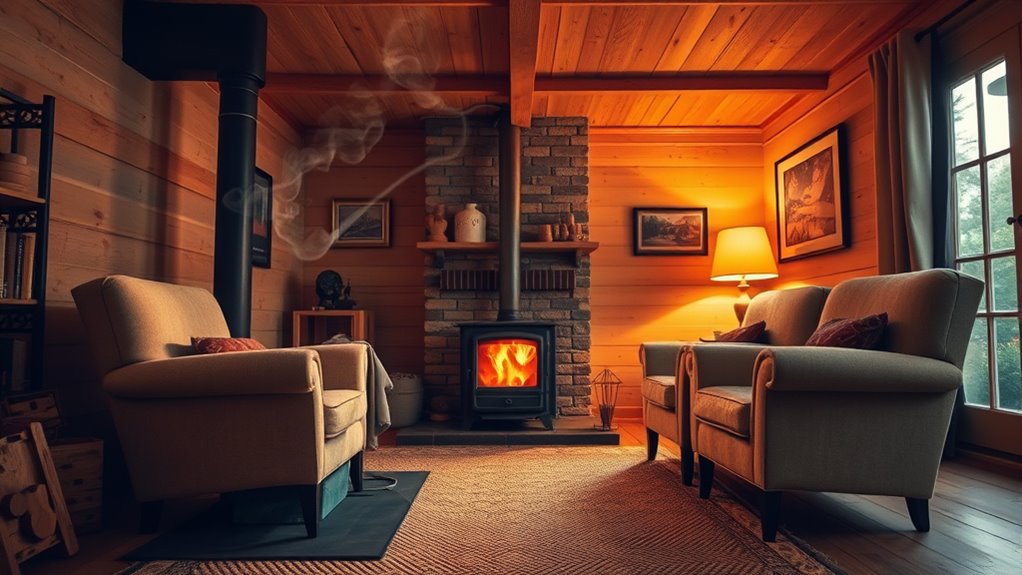
Exposure to wood smoke can cause coughing, wheezing, and worsen asthma, especially in children and those with existing conditions. Long-term inhalation raises your risk of lung cancer, heart problems, and early death. Vulnerable groups like kids, the elderly, and pregnant women face even greater health dangers from indoor wood smoke. Vetted portable heating options can help reduce indoor wood smoke exposure by providing cleaner alternatives. Proper ventilation and maintenance of your heating equipment are also essential to minimize health risks, as filtering indoor air effectively can significantly decrease harmful particle levels. Incorporating effective mixing techniques in air filtration systems can further improve indoor air quality. Additionally, understanding the health risks linked to wood smoke exposure can motivate the adoption of safer heating practices.
Respiratory Health Effects
Inhaling wood smoke particles can considerably impact your respiratory health, leading to issues like coughing, wheezing, and worsening asthma symptoms. Fine particulate matter, especially PM2.5 from wood burning, penetrates deep into your lungs and can enter your bloodstream, raising the risk of lung infections and chronic lung disease. Exposure to indoor air pollution from wood smoke also increases the likelihood of bronchitis and respiratory infections, particularly in children. Nitrogen oxides and volatile organic compounds released during combustion irritate your respiratory tract and impair lung function. Understanding the composition of wood smoke can help you recognize the specific pollutants responsible for these health effects. Additionally, the rise of clean beauty practices emphasizes reducing harmful chemical exposure, which parallels efforts to improve indoor air quality. Recognizing common sources of indoor pollution like wood stoves can help you take targeted steps to protect your respiratory health. Moreover, public awareness campaigns about indoor pollution can enhance understanding and motivate healthier choices. – Wood smoke emissions worsen indoor air quality, heightening your risk of respiratory problems. – Fine particulate matter causes inflammation and long-term lung damage. – Vulnerable groups, like children and those with preexisting conditions, face higher risks of lung disease from indoor wood smoke exposure.
Vulnerable Populations at Risk
Vulnerable populations, such as children, pregnant women, and older adults, face heightened health risks from indoor wood smoke because their developing or weakened respiratory and immune systems cannot effectively cope with pollutants. Children are especially at risk, as their lungs are still developing and they breathe in more air relative to their body weight, increasing exposure to fine particulate matter. Those with pre-existing conditions like asthma or heart disease experience worsened symptoms and increased health complications due to indoor air pollution. Low-income households are often forced to burn wood out of necessity, leading to chronic exposure and higher risks of respiratory infections, asthma attacks, and long-term health problems. Additionally, implementing proper ventilation and air filtration systems can significantly reduce indoor pollutant levels and protect these vulnerable groups from wood smoke exposure. Protecting these vulnerable groups from wood smoke exposure is essential to reducing their health risks.
Strategies to Minimize Indoor Pollution From Wood Burning
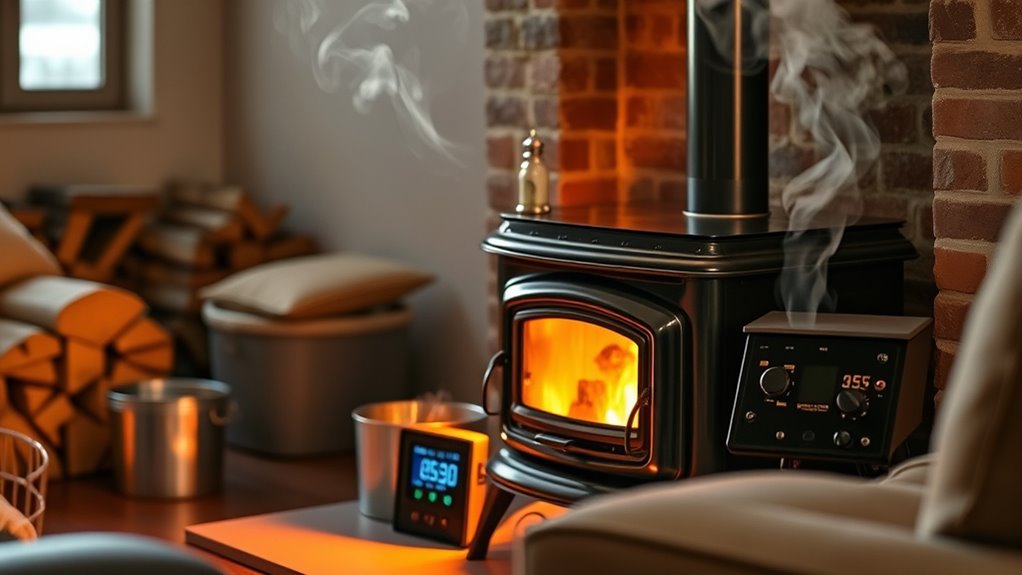
To minimize indoor pollution from wood burning, you should focus on using dry, seasoned firewood with moisture content below 20%, which promotes cleaner combustion and produces less smoke. Properly seasoned wood reduces particulate matter and emissions, improving your indoor air quality. Regularly maintain and clean your wood stove, including chimney inspections, to prevent blockages and ensure efficient combustion. Burn fires hot and fully, avoiding green or damp wood, to decrease incomplete combustion and harmful pollutants. Additionally, avoid burning plastics, treated wood, or household waste, as these produce toxic fumes. To further improve air quality, consider using an air purifier with HEPA and activated carbon filters to reduce residual smoke odors and particles. Proper cleaning and maintenance are key to keeping indoor air safe.
The Role of Air Purifiers in Improving Indoor Air

Air purifiers play a crucial role in enhancing indoor air quality, especially when wood stoves are in use. They effectively reduce particulate matter, smoke particles, and VOCs produced by burning wood. HEPA filters capture tiny particles, including harmful smoke, while activated carbon filters target gaseous emissions like formaldehyde and odors. Specialty filters like True HEPA combined with activated carbon are particularly efficient at improving air quality during stove operation. Smart air purifiers equipped with sensors, such as SensorPod®, automatically adjust fan speeds based on real-time air quality measurements, optimizing filtration. When used alongside proper ventilation and stove maintenance, air purifiers markedly lower indoor pollutant levels, creating a safer environment for vulnerable groups like children and respiratory-sensitive individuals.
Policies and Community Efforts to Reduce Wood Smoke Pollution
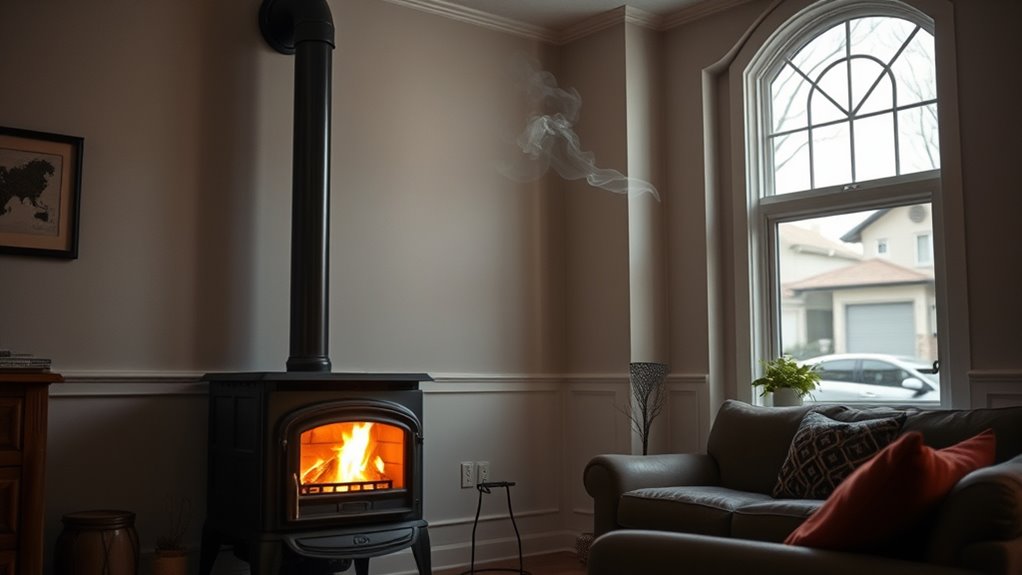
Communities across the United States are taking active steps to reduce wood smoke pollution through policies and local initiatives. Many are implementing stove change-out programs and stricter emission reduction policies that encourage replacing outdated stoves with EPA-certified models or cleaner heating solutions. Federal and state agencies, like the EPA, provide guidance and funding to support these efforts, especially targeting vulnerable populations. These initiatives aim to improve indoor air quality and reduce residential wood smoke. Community efforts include air pollution monitoring and awareness campaigns to engage residents in reducing emissions. Policymakers are also advocating for a gradual phase-out of traditional wood stoves, promoting renewable heating options like heat pumps. These combined actions help create healthier environments and lower air pollution levels in affected communities.
Communities are reducing wood smoke pollution through policies, stove upgrades, monitoring, and renewable heating solutions.
- *Stove change-out programs* incentivize upgrading to EPA-certified stoves.
- *Air pollution monitoring* tracks progress and identifies pollution hotspots.
- *Community awareness campaigns* foster public engagement and support vulnerable populations.
Frequently Asked Questions
Do Wood Stoves Affect Indoor Air Quality?
Yes, wood stoves can affect your indoor air quality. When you use them, they emit fine particles and gases like carbon monoxide and nitrogen dioxide, which can raise pollution levels inside your home. Incomplete burning releases harmful chemicals. To keep your indoor air safe, make certain your stove is well-maintained, use EPA-certified models, and improve ventilation. Regular care and proper operation help minimize health risks for everyone, especially vulnerable groups.
Do You Need an Air Purifier if You Have a Wood Stove?
You might wonder if an air purifier is necessary with a wood stove. Studies show indoor pollution can triple during use, so it’s wise to contemplate one. Air purifiers with HEPA and activated carbon filters can cut fine particles and gaseous pollutants, helping protect your health. Combining an air purifier with proper ventilation ensures cleaner indoor air, especially if you burn wood frequently or in high-emission stoves.
Are Wood-Burning Stoves Safe Indoors?
You wonder if wood-burning stoves are safe indoors. While they can provide warmth and ambiance, they also emit harmful pollutants like fine particles, carbon monoxide, and chemicals that can harm your health. Proper maintenance, good ventilation, and burning seasoned wood help reduce risks, but they don’t eliminate pollution entirely. Vulnerable family members, like children or the elderly, face higher health risks, so consider safety measures or alternatives.
Is It Safe to Sleep in a Room With a Wood Burner?
Did you know that sleeping in a room with a wood burner can expose you to dangerous levels of carbon monoxide? You might think it’s safe, but incomplete combustion releases harmful pollutants, especially if the stove isn’t well-maintained or ventilated. To stay safe, guarantee proper ventilation, use certified appliances, and install carbon monoxide detectors. These steps help protect you from potential poisoning during sleep.
Conclusion
If you use a wood stove, staying informed helps protect your indoor air quality. For example, imagine a family who switched to an EPA-certified stove and added air purifiers—noticeably fewer smoky odors and better health reports. By choosing cleaner-burning stoves, venting properly, and supporting community policies, you can reduce health risks for your loved ones. Taking these steps makes your home safer and more comfortable for everyone.

